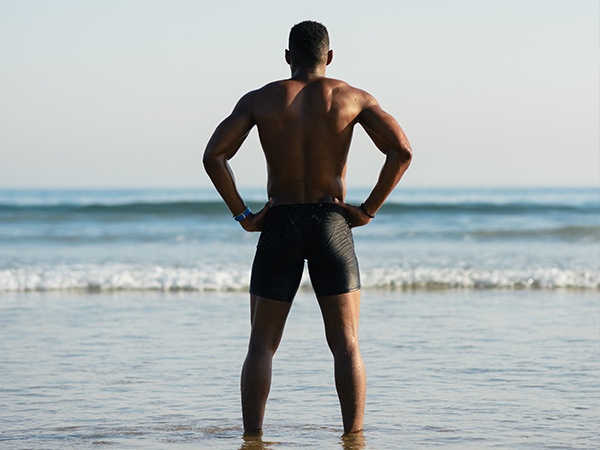
9 tips for planning a sea swim
You arrive at a beach. You haven’t been in the sea for a long time and you are eager to get in and get your salt-water fix. But how do you know it’s safe? Do you know what the tides are doing? Whether there are currents to be aware of? Are the waves a bit too big? Are those dumping waves? Which way is the wind blowing?
With more of us heading to UK beaches to get our swimming fix this summer, it is more important than ever that as open water swimmers we know how to read the water, and what to do if we, or others, get into trouble.
1. Never underestimate the value of local knowledge
When planning a sea swim, local knowledge is absolutely essential. Even the most experienced open water swimmer would not know simply by just looking at the sea whether a beach is safe to swim or not. How for example, if you arrived at a beach at high tide, would you know that there were rocks just below the surface, unless someone told you they were there? How would you know if there were jellyfish, or weaverfish? However confident you feel, it is always a good idea to speak to local swimmers or wild swimming groups beforehand if you can. If a beach is lifeguarded, chat to the lifeguards before you get in. Let them know what you are planning and ask them about the local conditions.
Sailing clubs, kayaking / SUP clubs and fishermen can also be a great source of local knowledge too.
2. Know your tides and what they mean for your swim
Many people find tides confusing when planning swims. Here are a few simple tips from Sam Kendrick to bear in mind:
On the coast, there are two high and two low tides every day (or every 24 hours and 50 minutes). It may sound simple, but when planning a swim it is crucial to remember that at any given location on the coast the tidal current usually flows parallel to shore, rather than perpendicular to it – which is easy to overlook when we talk about tides coming ‘in’ and going out’.
The speed at which tides move is also useful to know. Generally, water flows along the coast for six hours at a time, before changing direction. The tide will move fastest in the third and fourth hours, and slows down to a ‘slack’ water just before the tide turns.
Slack water usually occurs around 30-45 minutes either side of high tide and is a period of time where the water isn’t moving very much – which can be useful when planning a swim. (Note – this isn’t always the case! In many locations along the Norfolk coast for example, slack water occurs 2-3 hours before high tide … so it’s always worth checking with locals too). The speed of the tidal flow can also vary considerably depending on location, springs, neaps and the topography of the land.
Every month, there will be two Spring tides (one at new moon, one at full moon) and two neap tides. Spring tides have greater depth range between high and low water and neap tides have less variation between high and low water.
Remember to prepare for after your swim too! You could have a great time in the water, but if you don’t have the correct gear at the end – warm dry clothes, a hat, a warm drink and of course – cake (!) then it is easy to ruin a good time.
Knowing whether you are swimming on a neap or a spring tide is useful, as tidal flow is likely to be stronger on springs than on neaps.
We have a detailed article on understanding tides for sea swimmers.
3. Wind is key
Weather may seem like an obvious consideration when planning a swim, but it’s about more than just remembering your sun-cream. The most important weather consideration for sea swimmers is wind. “The Beaufort Scale is a really useful tool for open water swimmers” explains SwimQuest guide Guy Metcalf. “Not only is it the most widely used method for measuring wind speed internationally, it is based on visual clues – so you don’t need any fancy equipment to be able to tell the wind speed, or speak to other water users about it. On SwimQuest tours, usually we would not swim with groups in wind speeds of more than Beaufort 3-4, so for example – when the crests on the top of large wavelets begin to break, you start to see scattered whitecaps, and the wind starts to ‘fill a flag’.”
The direction of the wind is also important – is it blowing with or against the tidal flow? Is it blowing off shore or on shore? Collect this information before your swim and start to build a picture of what these conditions mean for you, taking into account tidal flow as well. For example, often wind over tide (wind blowing in the opposite direction to tidal flow) can cause short, very choppy conditions, which can be disorientating and uncomfortable to swim in for many.
Nick Ayers explains: “If you are in any doubt as to which direction the water is moving in, get in and do a float test. Float on your back for around 90 seconds, and take note of where you are moving in relation to a fixed point on the shoreline.
This is something we also advise our lifeguards to do regularly, as often it is difficult to tell exactly what the conditions are like, especially when wind and tidal factors are in play.”
4. Be wave aware
Dumping waves are probably most dangerous to swimmers. Dumping waves usually occur on steep shelving beaches, such as the beaches on the UK’s south coast – Brighton, Hastings as examples. These waves usually cause problems for swimmers on entry and exit, as they can break with force and knock you off your feet and pull you under and back out. If this does happen – it is important to stay calm, wait until the motion ceases and then try to stand up again and ‘crab’ your feet up the beach, planting them firmly and side stepping your way out. “Waves come in sets,” Nick explains, “usually of around 6-7. Before you get in, try to count how many waves in a set on that given day. The gap is a great time to enter or exit the water before the next set rolls in.”
5. Check out Dr Rip!
Rip currents are common and can be extremely dangerous if you are not prepared. As the water moves towards the land, it needs to find a way to get back out to sea – and it will do so via the route of least resistance. Rips are narrow and powerful, often impossible to swim against (even for an Olympic swimmer!). To spot a rip, look for a break in the incoming wave pattern.
“Often people think this quiet looking water is the safest area to swim – when actually the opposite is true!” explains Sam. “Lifeguards will usually put out their red and yellow flags (the swim area) on sandbanks, so, where the waves are crashing in. Water either side of these wave banks is likely to be a rip, and moving back out to sea.”
If you get caught in a rip, the way to get out is to either float on your back (or swim, if you feel comfortable) until you reach the head of the rip, then swim parallel to the shore before swimming back in through the waves.
You can, if you feel comfortable, attempt to swim out of the rip at a 45 degree angle (a bit like following the exit signs on an aircraft!) A couple of key points to remember here – rips will not take you miles out to sea! They are likely to only be around 100m maximum, and they will not pull you under the water. So, if you get caught in a rip, stay calm, let it take you out, and then swim parallel to the shore to get back to the coast. If you haven’t discovered him already – check out Dr Rip on You Tube, there are some amazing videos which clearly show how the water moves in a rip current.
6. Open water? It’s a team game
Never ever swim alone. Ideally, you should be swimming with a buddy. Have a clear plan before you enter the water, and keep an eye on each other throughout your swim. In addition, and especially if you are going for a longer swim, it is a good idea to have a land-based contact who can either keep an eye on you in the water, or whom you can check in with once you exit the water. SafeTrx is a very useful app which you can set up with your emergency contacts, create a ‘sail plan’, type in your ETA etc and what you will be wearing. It has a simple push to call 999 for the Coastguard, and your last known location will show on their screens. Taking a mobile phone with you in a tow float is also a good idea.
7. Float to Live
If you, or anyone you are swimming with, has a panic, try to remember the RNLI advice ‘Float to Live’. Lean back, extend your arms and legs, and if you need to, gently move them around to help you float. Float until you can control your breathing – this usually takes around 90 seconds.
Often, you will find that this simple 90 second exercise gives you enough composure to gather your thoughts and swim to safety. If you still don’t feel comfortable, continue to float, wave one arm in the air from side to side, and shout for help.
8. Do not enter the water after a casualty
“Often this one seems a difficult suggestion if you consider yourself a competent open water swimmer, but most drownings happen as a result of someone going in to save someone else in trouble.” Nick explains: “Unless you are qualified to do so and have relevant rescue equipment to hand, the best and most useful thing you can do is to call 999 and ask for the coastguard. Keep an eye on the casualty and keep the coastguard updated.”
9. Tell the beach lifeguard or coastguard
If you’re swimming at a lifeguarded beach, tell the lifeguards where you’re planning to swim and for how long. It doesn’t matter that you’re swimming beyond the red and yellow flags – the lifeguard will be able to keep an eye on you. If you’re swimming a longer distance and away from beaches, let the local coastguard know. This saves them trying to rescue you when well-meaning members of the public spot you from the coast path and call it in!
The advice in this article was provided by: Nick Ayers, RNLI Water Safety Lead for the North East of England; Sam Kendrick, Lifeguard Supervisor in the Norfolk Broads area for over 12 years; and Guy Metcalf, an RNLI Lifeguard Supervisor on the Norfolk coastline.







